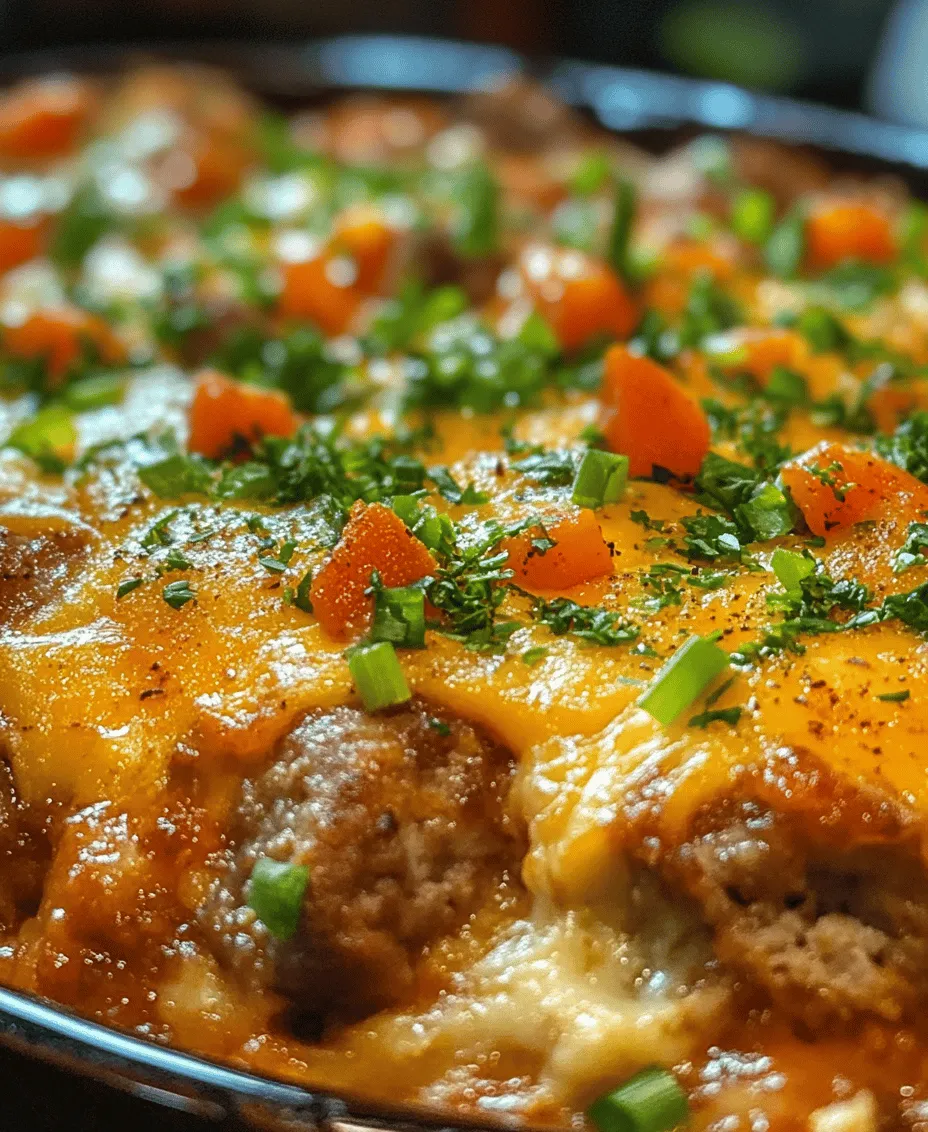Introduction
Breakfast is often hailed as the most important meal of the day, and for good reason. It breaks the overnight fast and kick-starts your metabolism, providing essential nutrients to fuel your morning activities. However, with busy schedules and the hustle of daily life, preparing a wholesome breakfast can sometimes feel like a daunting task. This is where breakfast casseroles come into play as a convenient and hearty meal option. Among these, the Classic Breakfast Sausage and Egg Casserole stands out as an ideal solution for families and gatherings alike. Its savory blend of flavors is not only satisfying but also easy to prepare, making it a beloved choice for busy mornings or festive brunches.
The appeal of this casserole lies in its ability to combine multiple breakfast staples into one dish, allowing you to serve a crowd without the hassle of cooking several individual items. Whether you’re feeding a family on a Sunday morning or hosting friends for a holiday brunch, this breakfast casserole promises to please everyone at the table.
In this article, we will delve into the rich history of breakfast casseroles, explore the essential ingredients that make this dish so delicious, and provide you with a step-by-step guide to crafting the perfect Classic Breakfast Sausage and Egg Casserole.
Understanding Breakfast Casseroles
Definition and History of Breakfast Casseroles
A breakfast casserole is essentially a baked dish that combines various breakfast ingredients, typically including eggs, dairy, meats, vegetables, and sometimes bread or potatoes. The concept of casseroles dates back to the 18th century, where the term “casserole” originally referred to the dish in which the meal was cooked. Over time, this method of cooking evolved, and casseroles became a popular way to prepare meals that could be made in advance and easily served to a group.
Breakfast casseroles gained prominence in the United States during the mid-20th century, particularly in the post-World War II era when home cooking became a cherished tradition. The convenience of preparing a single dish that could cater to a family or gathering made breakfast casseroles a staple in many households. Today, they continue to be a beloved choice, offering a versatile platform that allows for creativity while still being grounded in tradition.
The Versatility of Breakfast Casseroles
One of the most appealing aspects of breakfast casseroles is their versatility. Different cultures and cuisines have their own takes on this hearty dish. For instance, the Spanish frittata is a baked egg dish filled with vegetables and potatoes, while the French quiche incorporates a flaky crust and custard-like filling. In the United States, breakfast casseroles often feature ingredients like sausage, cheese, and hash browns, but the possibilities are virtually endless.
This versatility allows home cooks to adapt the dish according to personal tastes or dietary restrictions. Whether you prefer a vegetarian version packed with seasonal vegetables, or you want to indulge in a meat-laden casserole, breakfast casseroles can be tailored to suit any palate.
Benefits of Preparing Breakfast Casseroles
Preparing a breakfast casserole comes with several benefits:
1. Time-Saving: Breakfast casseroles can be made in advance, allowing you to prepare a hearty meal the night before. This means that on busy mornings, you can simply pop it in the oven and enjoy a warm breakfast without the fuss of cooking from scratch.
2. Meal Prep: A well-portioned casserole can serve as an excellent meal prep option, providing you with nutritious breakfasts for the week ahead. Just slice and store in the refrigerator, and reheat as needed.
3. Feeding a Crowd: Whether you have family visiting or you are hosting a brunch, casseroles are an efficient way to feed a large group. One dish can typically serve many, reducing the need for multiple pots and pans.
4. Creative Freedom: With a breakfast casserole, the sky’s the limit. You can experiment with flavors, textures, and ingredients, making each casserole a unique creation.
Ingredients Breakdown
Now that we’ve discussed the allure and benefits of breakfast casseroles, let’s take a closer look at the key ingredients that make the Classic Breakfast Sausage and Egg Casserole so delicious.
Breakfast Sausage
At the heart of this casserole is breakfast sausage, which adds both flavor and protein. The choice of sausage is crucial; whether you prefer spicy, mild, or herbed varieties, each will impart a unique taste to the dish. Cooking the sausage properly enhances its natural flavors, providing a savory base that complements the other ingredients.
Eggs
Eggs are the star ingredient in any breakfast casserole. They act as a binding agent, holding the dish together while providing essential nutrition. Rich in protein, healthy fats, and vitamins, eggs contribute to a well-rounded breakfast. The number of eggs used can vary based on the size of your casserole and the number of servings you wish to create.
Milk
Adding milk to the egg mixture introduces a delightful creaminess and richness to the casserole. It also helps to create a custard-like consistency, which is key to the texture of the final dish. Whole milk is commonly used, but you can substitute with lower-fat options or non-dairy alternatives if desired.
Hash Browns
Hash browns serve as the backbone of this casserole, providing both texture and heartiness. They soak up the flavors of the sausage and eggs, creating a satisfying base. You can use frozen hash browns for convenience or grate fresh potatoes if you prefer a homemade touch.
Cheese
No breakfast casserole would be complete without cheese. It adds flavor, creaminess, and that irresistible melty goodness that everyone loves. Cheddar is a popular choice, but you can experiment with other cheeses like mozzarella, pepper jack, or even feta to create a different flavor profile.
Optional Ingredients
To enhance your casserole further, consider adding optional ingredients such as green onions or bell peppers. These not only add freshness and color but also contribute additional nutrients and flavor. Feel free to mix and match vegetables according to your preferences.
Ingredient Substitutions
One of the great things about breakfast casseroles is their adaptability. If you have dietary restrictions or preferences, there are numerous substitutions you can make:
– For a vegetarian option, replace the sausage with plant-based sausage or skip it altogether, incorporating more vegetables like spinach, zucchini, or mushrooms.
– For a lactose-free version, use almond milk or oat milk and opt for dairy-free cheese.
– If you’re watching your carb intake, consider using cauliflower rice instead of hash browns.
Step-by-Step Cooking Instructions
Preheating the Oven and Preparing the Casserole Dish
Before diving into the cooking process, it’s essential to preheat your oven to 350°F (175°C). This ensures that your casserole cooks evenly and thoroughly. While the oven is heating, prepare your casserole dish by lightly greasing it with cooking spray or butter. This step is crucial for preventing the casserole from sticking, allowing for easy serving later on.
Cooking the Sausage
Next, it’s time to cook the breakfast sausage. In a large skillet over medium heat, add the sausage and break it up with a spatula as it cooks. Aim for a nice browning on the sausage, which will enhance its flavor and add depth to the dish. Cook until the sausage is fully browned and no longer pink, typically around 5-7 minutes.
Once cooked, drain any excess fat and allow the sausage to cool slightly before adding it to the egg mixture. This step is important to prevent the eggs from cooking prematurely when mixed.
Combining Ingredients
While the sausage is cooling, whisk together the eggs and milk in a large bowl until well combined. Season with salt, pepper, and any additional spices you prefer, such as paprika or cayenne pepper for a little kick. Once the mixture is ready, stir in the cooked sausage, hash browns, and cheese until everything is evenly distributed. If you’re using any optional ingredients like green onions or bell peppers, fold them in at this stage for an added burst of flavor.
Following these initial steps will set you on the right path to creating a delightful Classic Breakfast Sausage and Egg Casserole. The combination of savory sausage, creamy eggs, and hearty hash browns creates a satisfying dish that is sure to become a favorite in your breakfast rotation. Stay tuned for the remaining steps to complete this delicious recipe!

How to Drain Grease Effectively
After cooking your breakfast sausage, you’ll notice that it releases quite a bit of grease. While some grease can enhance flavor, too much can make your casserole greasy and unappetizing. To effectively drain the grease, follow these simple steps:
1. Remove the Sausage from the Pan: After the sausage is fully cooked and browned, transfer it to a plate lined with paper towels. This will absorb excess grease while keeping the sausage warm.
2. Tilt the Pan: Instead of pouring the grease down the sink, which can clog your plumbing, carefully tilt the pan. Allow the grease to pool at one side, and then use a spoon to scoop it out. Be cautious as the pan will be hot.
3. Strain if Necessary: If you have a considerable amount of grease left in the pan, consider using a fine-mesh strainer. Pour the grease through the strainer into a heatproof container. Allow it to cool and solidify before disposing.
Preparing the Egg Mixture
The egg mixture is the heart of your breakfast casserole, and preparing it properly is essential for achieving that fluffy, delicious texture. Start by gathering the following ingredients:
– 8 large eggs
– 1 cup milk (whole or 2% works best)
– Salt and pepper to taste
– Optional: 1 teaspoon of garlic powder or onion powder for added flavor
The Significance of Whisking for Texture and Consistency
Whisking is crucial in this step as it incorporates air into the egg mixture, leading to a light and fluffy casserole. Here’s how to whisk effectively:
1. Combine Ingredients: In a large mixing bowl, crack the eggs and add in the milk, salt, pepper, and any optional seasonings.
2. Whisk Vigorously: Use a whisk or a fork and mix vigorously until the yolks are fully blended with the whites and the mixture is frothy. This process should take about 1-2 minutes.
3. Check for Uniformity: Ensure that there are no streaks of yolk remaining. A well-whisked mixture will yield a consistent texture throughout the casserole.
Layering the Casserole
Layering your casserole correctly is essential for ensuring an even distribution of flavors and textures. Here’s how to achieve this:
1. Prepare Your Baking Dish: Preheat your oven to 350°F (175°C). Grease a 9×13-inch baking dish with cooking spray or butter to prevent sticking.
2. Add Ingredients in Layers: Start with the base layer of cooked and drained sausage, spreading it evenly across the bottom of the baking dish. This will create a solid foundation for the casserole.
3. Incorporate Vegetables: If you’re adding vegetables like bell peppers, onions, or spinach, distribute them evenly over the sausage layer. This allows the flavors to meld as they bake.
4. Pour the Egg Mixture: Slowly pour the whisked egg mixture over the layered ingredients. This will help the eggs seep through the layers, ensuring every bite is flavorful.
5. Top with Cheese: Finish with a generous layer of shredded cheese on top. This not only adds flavor but also creates a delicious, golden-brown crust as it bakes.
Baking Tips
Baking your casserole to perfection requires attention to detail. Here are some tips to ensure your dish turns out beautifully:
1. How to Determine Doneness: Bake the casserole for about 30-35 minutes. To check for doneness, insert a knife into the center. If it comes out clean and the eggs are set, your casserole is ready. The cheese should also be golden and bubbly.
2. Cooling Before Slicing: Once baked, allow the casserole to cool for at least 10-15 minutes before slicing. This resting time helps the casserole set, making it easier to cut and serve while maintaining its structure.
Nutritional Information
Understanding the nutritional profile of your breakfast casserole can help you enjoy it guilt-free. Here’s a breakdown based on a serving size of one-sixth of the casserole:
– Calories: Approximately 320
– Protein: 20g
– Fats: 22g
– Carbohydrates: 8g
Discussion on the Health Benefits of the Key Ingredients
– Eggs: A great source of high-quality protein, vitamins B12 and D, and choline, which is essential for brain health.
– Sausage: Provides protein and essential fats, but be mindful of the sodium content. Opt for lean sausage to reduce calories.
– Vegetables: Adding vegetables increases the fiber content, vitamins, and minerals, making the casserole more nutritious overall.
Exploring the Balance of Macronutrients in the Casserole
This casserole is balanced with a good mix of protein from the eggs and sausage, healthy fats from the cheese and sausage, and carbohydrates from any added bread or vegetables. This balance makes it a satisfying meal that keeps you full longer.
Serving Suggestions
To elevate your breakfast casserole experience, consider these serving suggestions:
1. Ideas for Sides and Accompaniments: Pair your casserole with fresh fruit (like berries or melon), crispy toast, or even a light salad. A cup of freshly brewed coffee or a refreshing juice can complement the meal beautifully.
2. Presentation Tips: For a beautiful brunch spread, serve the casserole directly from the baking dish, garnished with fresh herbs like parsley or chives. Use colorful plates to enhance the visual appeal.
3. Seasonal Variations: Adapt this casserole for holidays by incorporating seasonal ingredients. For instance, add pumpkin and sage for a fall twist, or fresh asparagus and feta for a springtime version.
Storing and Reheating Leftovers
If you find yourself with leftovers (which is rare given how delicious this casserole is), here’s how to store and reheat them properly:
1. Best Practices for Storing: Allow the casserole to cool completely before transferring it to an airtight container. It can be stored in the refrigerator for up to 3-4 days or frozen for up to 2 months.
2. How to Reheat for Optimal Taste and Texture: When ready to enjoy your leftovers, reheat individual portions in the microwave for about 1-2 minutes, or warm the entire casserole in the oven at 350°F (175°C) for 20-25 minutes until heated through.
3. Creative Ways to Repurpose Leftovers: Transform leftover casserole into breakfast wraps by placing slices in tortillas with fresh greens and salsa. Alternatively, chop it up and toss it into a salad for a hearty lunch.
Conclusion
The Classic Breakfast Sausage and Egg Casserole is not just a meal; it’s a delightful experience that brings people together. Its versatility allows for customization to suit personal tastes and dietary needs, making it a perfect dish for gatherings, holidays, or a simple weekend brunch.
Sharing meals with family and friends is one of life’s greatest joys, and this casserole makes it easy to create lasting memories around the table. Don’t hesitate to experiment with the ingredients and flavors to make this dish your own, ensuring that every bite is a celebration of your culinary creativity. Enjoy cooking, sharing, and savoring this classic breakfast treat!

